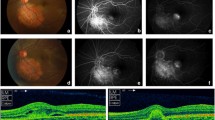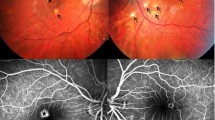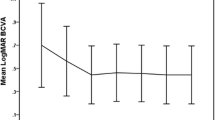Abstract
Purpose
To assess the short-term efficacy and safety of intravitreal bevacizumab injections (IVB) for refractory choroidal neovascularization (CNV) secondary to uveitis.
Methods
Ten patients affected by choroidal neovascularization secondary to uveitis unresponsive to immunosuppression associated or not with photodynamic therapy (PDT) were consecutively included. All patients underwent a complete ophthalmic examination including best-corrected visual acuity (BCVA), fluorescein (FA) and indocyanine green angiographies (ICG), optical coherence tomography (OCT) at baseline, and after IVB injection (1.25 mg/0.05 ml).
Results
CNV was subfoveal in eight cases and juxtafoveal in two cases. Mean follow-up was 7.5 months. After treatment, the logMAR BCVA improved from 0.62 ± 0.4 (Snellen equivalent of 20/55) to 0.45 ± 0.35 (Snellen equivalent of 20/40) at 1 month (p = 0.01), then remained stable during the follow-up. Mean central macular thickness (CMT) was reduced from 326 ± 95 μm before treatment to 267 ± 28 μm (p = 0.03) at last visit. Mean number of IVB was 2.5. Leakage from inflammatory CNV was stopped in three eyes and decreased in seven eyes. No systemic or ocular adverse events were recorded.
Conclusions
Intravitreal bevacizumab improves BCVA and reduces central macular thickness in eyes with inflammatory CNV refractory to immunosuppression associated or not with PDT. Further study is necessary to assess the efficacy and safety in the long term.



Similar content being viewed by others

References
Flaxel CJ, Owens SL, Mulholland B, Schwartz SD, Gregor ZJ (1998) The use of corticosteroids for choroidal neovascularisation in young patients. Eye 12(Pt 2):266–272
Hogan A, Behan U, Kilmartin DJ (2005) Outcomes after combination photodynamic therapy and immunosuppression for inflammatory subfoveal choroidal neovascularisation. Br J Ophthalmol 89:1109–1111, doi:10.1136/bjo.2004.063024
Thorne JE, Wittenberg S, Jabs DA, Peters GB, Reed TL, Kedhar SR et al (2006) Multifocal choroiditis with panuveitis incidence of ocular complications and of loss of visual acuity. Ophthalmology 113:2310–2316, doi:10.1016/j.ophtha.2006.05.067
Giovannini A, Neri P, Mercanti L, Brue C (2007) Photodynamic treatment versus photodynamic treatment associated with systemic steroids for idiopathic choroidal neovascularisation. Br J Ophthalmol 91:620–623, doi:10.1136/bjo.2006.103135
Leslie T, Lois N, Christopoulou D, Olson JA, Forrester JV (2005) Photodynamic therapy for inflammatory choroidal neovascularisation unresponsive to immunosuppression. Br J Ophthalmol 89:147–150, doi:10.1136/bjo.2004.046623
Nowilaty SR, Bouhaimed M (2006) Photodynamic therapy for subfoveal choroidal neovascularisation in Vogt-Koyanagi-Harada disease. Br J Ophthalmol 90:982–986, doi:10.1136/bjo.2006.091538
Parodi MB, Iacono P, Spasse S, Ravalico G (2006) Photodynamic therapy for juxtafoveal choroidal neovascularization associated with multifocal choroiditis. Am J Ophthalmol 141:123–128, doi:10.1016/j.ajo.2005.07.045
Brown DM, Regillo CD (2007) Anti-VEGF agents in the treatment of neovascular age-related macular degeneration: applying clinical trial results to the treatment of everyday patients. Am J Ophthalmol 144:627–637, doi:10.1016/j.ajo.2007.06.039
Emerson MV, Lauer AK, Flaxel CJ, Wilson DJ, Francis PJ, Stout JT et al (2007) Intravitreal bevacizumab (Avastin) treatment of neovascular age-related macular degeneration. Retina 27:439–444, doi:10.1097/IAE.0b013e31804b3e15
Hernandez-Rojas ML, Quiroz-Mercado H, Dalma-Weiszhausz J, Fromow-Guerra J, Amaya-Espinosa A, Solis-Vivanco A et al (2007) Short-term effects of intravitreal bevacizumab for subfoveal choroidal neovascularization in pathologic myopia. Retina 27:707–712
Rinaldi M, Dell’Omo R, Romano MR, Chiosi F, Cipollone U, Costagliola C (2007) Intravitreal bevacizumab for choroidal neovascularization secondary to angioid streaks. Arch Ophthalmol 125:1422–1423, doi:10.1001/archopht.125.10.1422
Mandal S, Garg S, Venkatesh P, Mithal C, Vohra R, Mehrotra A (2007) Intravitreal bevacizumab for subfoveal idiopathic choroidal neovascularization. Arch Ophthalmol 125:1487–1492, doi:10.1001/archopht.125.11.1487
Gomi F, Nishida K, Oshima Y, Sakaguchi H, Sawa M, Tsujikawa M et al (2007) Intravitreal bevacizumab for idiopathic choroidal neovascularization after previous injection with posterior subtenon triamcinolone. Am J Ophthalmol 143:507–510, doi:10.1016/j.ajo.2006.10.050
Chan WM, Lai TY, Liu DT, Lam DS (2007) Intravitreal bevacizumab (avastin) for choroidal neovascularization secondary to central serous chorioretinopathy, secondary to punctate inner choroidopathy, or of idiopathic origin. Am J Ophthalmol 143:977–983, doi:10.1016/j.ajo.2007.02.039
Adan A, Mateo C, Navarro R, Bitrian E, Casaroli-Marano RP (2007) Intravitreal bevacizumab (avastin) injection as primary treatment of inflammatory choroidal neovascularization. Retina 27:1180–1186
Macular Photocoagulation Study Group (1987) Krypton laser photocoagulation for neovascular lesions of ocular histoplasmosis. Results of a randomized clinical trial. Arch Ophthalmol 105:1499–1507
Morgan CM, Schatz H (1986) Recurrent multifocal choroiditis. Ophthalmology 93:1138–1147
Read RW, Holland GN, Rao NA, Tabbara KF, Ohno S, Arellanes-Garcia L et al (2001) Revised diagnostic criteria for Vogt-Koyanagi-Harada disease: report of an international committee on nomenclature. Am J Ophthalmol 131:647–652, doi:10.1016/S0002–9394(01)00925–4
Lim WK, Buggage RR, Nussenblatt RB (2005) Serpiginous choroiditis. Surv Ophthalmol 50:231–244, doi:10.1016/j.survophthal.2005.02.010
Dees C, Arnold JJ, Forrester JV, Dick AD (1998) Immunosuppressive treatment of choroidal neovascularization associated with endogenous posterior uveitis. Arch Ophthalmol 116:1456–1461
Fine SL, Wood WJ, Isernhagen RD, Singerman LJ, Bressler NM, Folk JC et al (1993) Laser treatment for subfoveal neovascular membranes in ocular histoplasmosis syndrome: results of a pilot randomized clinical trial. Arch Ophthalmol 111:19–20
Essex RW, Tufail A, Bunce C, Aylward GW (2007) Two-year results of surgical removal of choroidal neovascular membranes related to non-age-related macular degeneration. Br J Ophthalmol 91:649–654, doi:10.1136/bjo.2005.089458
Rogers AH, Duker JS, Nichols N, Baker BJ (2003) Photodynamic therapy of idiopathic and inflammatory choroidal neovascularization in young adults. Ophthalmology 110:1315–1320, doi:10.1016/S0161–6420(03)00466–4
Spaide RF, Freund KB, Slakter J, Sorenson J, Yannuzzi LA, Fisher Y (2002) Treatment of subfoveal choroidal neovascularization associated with multifocal choroiditis and panuveitis with photodynamic therapy. Retina 22:545–549, doi:10.1097/00006982–200210000–00003
Borkowski LM, Weinberg DV, Delany CM, Milsow L (2001) Laser photocoagulation for choroidal neovascularization associated with sympathetic ophthalmia. Am J Ophthalmol 132:585–587, doi:10.1016/S0002–9394(01)01044–3
Bom S, Young S, Gregor Z, Lightman S (2002) Surgery for choroidal neovascularization in sympathetic opthalmia. Retina 22:109–111, doi:10.1097/00006982–200202000–00021
Chan WM, Lai TY, Lau TT, Lee VY, Liu DT, Lam DS (2008) Combined photodynamic therapy and intravitreal triamcinolone for choroidal neovascularization secondary to punctate inner choroidopathy or of idiopathic origin: one-year results of a prospective series. Retina 28:71–80
Farah ME, Costa RA, Muccioli C, Guia TA, Belfort R (2002) Photodynamic therapy with verteporfin for subfoveal choroidal neovascularization in Vogt-Koyanagi-Harada syndrome. Am J Ophthalmol 134:137–139, doi:10.1016/S0002–9394(02)01456–3
Kinge B, Syrdalen P, Bjornsson OM (2005) Photodynamic therapy for choroidal neovascularization secondary to sympathetic ophthalmia. Retina 25:375–377, doi:10.1097/00006982–200504000–00023
Kuo IC, Rechdouni A, Rao NA, Johnston RH, Margolis TP, Cunningham ET (2000) Subretinal fibrosis in patients with Vogt-Koyanagi-Harada disease. Ophthalmology 107:1721–1728, doi:10.1016/S0161–6420(00)00244-X
Acknowlegements
Acknowledgements to Pr Gérard FORZY (Université Catholique de Lille, France) for the statistical analysis support.
Author information
Authors and Affiliations
Corresponding author
Additional information
None of the authors has any financial interest in this study.
The authors have full control of all primary data and agree to allow Graefe’s Archive for Clinical and Experimental Opthalmology to review the data if requested.
Rights and permissions
About this article
Cite this article
Tran, T.H.C., Fardeau, C., Terrada, C. et al. Intravitreal bevacizumab for refractory choroidal neovascularization (CNV) secondary to uveitis. Graefes Arch Clin Exp Ophthalmol 246, 1685–1692 (2008). https://doi.org/10.1007/s00417-008-0906-4
Received:
Revised:
Accepted:
Published:
Issue Date:
DOI: https://doi.org/10.1007/s00417-008-0906-4



